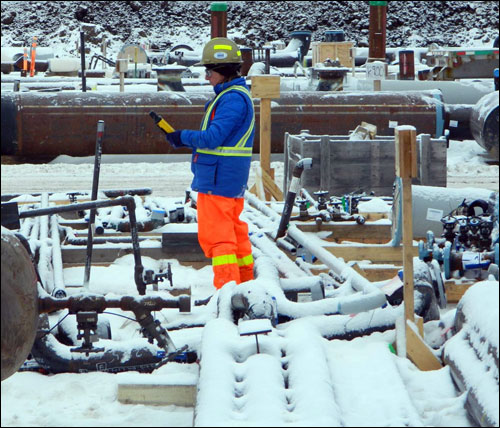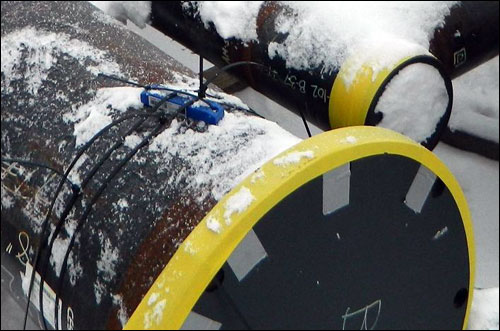Jun 21, 2013About five years ago, Atlas RFID Solutions developed a solution to track approximately 4,000 fabricated pipe spools (sections of pipe preassembled with flanges and other fittings) at the construction site of a power plant in Virginia. Based on that system's success, the company launched a full-scale construction-management solution, known as Jovix, which employs radio frequency identification tags and readers to monitor materials and tools at oil and gas facilities, power plants, and similar industrial construction projects—often from the point of an item's manufacture until it is built into the facility.
To meet a growing demand for its industrial asset-management solution, Atlas RFID opened an office in Calgary, Canada, in October 2012, in large part due to growth in the Jovix system's use to support oil-sands projects. Since then, five such projects in Canada have deployed the Jovix solution, according to Jon Chesser, Atlas RFID's Canada regional manager and VP of construction solutions. On average, each site tracks between 10,000 and 100,000 critical items, such as fabricated pipe spools, valves and cable. At one such location, the operator (which has asked to remain unnamed) has reduced its staff by 77 percent, by decreasing the amount of labor required to search for lost materials.

The Jovix system comes with RFID readers for tags, including a ruggedized tablet with a built-in reader for interrogating active ultrahigh-frequency (UHF) tags that construction site personnel can use to identify an item being moved. The device can also be operated in Geiger mode to locate a piece of equipment or a tool. In addition, the company provides fixed passive or active RFID readers to identify assets moving around a construction site or storage area.
Jovix also includes the use of vehicle-mounted devices with built-in RFID readers and GPS units. In this case, the device is installed in a truck or on a forklift, and personnel simply drive the vehicle around a construction site, warehouse or storage yard. The reader captures the ID numbers of all tags within the vicinity, and then couples that data with the vehicle's GPS location and forwards that information via a Wi-Fi or cellular connection, or stores it until the vehicle comes within range of a wireless network connection. The Jovix software can identify the locations of all items, and determine if anything has been moved since its last RFID tag read, as well as whether that location is the one that management would expect.
Atlas RFID provides its Jovix solution to project owners, such as oil and gas companies, as well as engineering, procurement and construction (EPC) contractors that serve such companies. The technology is also often employed by material vendors, fabricators and construction managers, to ensure that the correct items can be located and used throughout a project. The Jovix system consists of readers and tags supplied by a variety of vendors, depending on the application, as well as installation and software to manage data about the receipt, location and status of goods, based on RFID tag reads or bar-code scans.
The development of the Jovix solution began in about 2007, when Atlas RFID was approached by an EPC contractor working for Dominion, one of the nation's largest energy producers and transporters. The company sought to track the receipt, storage and use of structural steel on a construction site. Atlas RFID, which is a software provider, began researching RFID hardware options, and later designed a pilot project for Dominion's Virginia City Hybrid Energy Center.
Atlas RFID provided hardware and software to manage RFID data that would track the pipe spools, and agreed to pay for the cost of that software and hardware. The EPC contractor calculated the number of labor hours workers spent manually receiving each spool and tracking its location on the construction site, and compared that figure against the amount of labor expended with the Atlas RFID system in place. In the latter case, the EPC staff applied RFID tags to pipe spools and then located them within the storage yard via handheld readers. The two companies split the savings, Chesser says, noting that the EPC contractor had estimated it would take two man-hours to track each spool without RFID technology. With the Atlas RFID system, he reports, it took only about 15 minutes of labor to monitor each spool. The RFID-based tracking process consisted of applying RFID tags to each fabricated pipe spool as it was received, and linking the tag ID with the spool's GPS location. Employees then used the handheld device with RFID and GPS functionality to find the pipe spool when requested by the construction team.
Following that project, Atlas RFID commercialized the Jovix solution, which is now in use at several nuclear power plants, a liquefied natural gas (LNG) facility installation in Australia, and multiple oil-sands construction projects in Western Canada.
Initially, the technology—UHF and high-frequency (HF) passive tags, active RFID tags and bar-coded labels, as well as RFID readers and bar-code scanners—was used solely by EPC contractors. By tagging items and reading those tags or scanning bar codes on labels attached to materials as they were received or moved onsite, or installed in the construction site, the company was able to reduce the amount of time staff spent searching for goods, or ensuring that those materials were actually onsite. Typically, when a valve or other item arrived onsite, a tag was attached and read, with the unique ID linked to data identifying that item in the software. The tag could then be interrogated again by fixed readers at specific locations onsite as the valve is moved, or by mobile readers.
Recently, however, the technology's use has expanded to other members of the construction team, such as construction materials suppliers, Chesser says. Typically, after construction materials are manufactured, they are then shipped to a fabricator that puts together several components in order to produce a larger item to be installed onsite. Tracking each component, including when it was manufactured, when it was shipped to the fabricator and when it was then built into a larger component, is usually accomplished via paperwork and telephone calls. Therefore, EPC contractors sought to have the Jovix system extend to the point of the components' manufacture. Currently, the EPC contractor often requires that its vendors apply RFID tags to materials they supply, and the tags are then also read by fabricators that put together multiple components prior to shipping those fabricated items to the construction site. Data related to all of the RFID tag reads is stored on a server typically hosted by Atlas RFID and accessed by authorized supply chain members, as well as by project managers.
At the onset of each project, Atlas RFID meets with project managers to determine what it calls the Materials Responsibility Matrix. The managers can create a Materials Management Plan by assessing which objects will need to be tracked, at what point they should be tagged and what type of technology should be used.
"We consider ourselves a solution provider," Chesser states. "We aren't there to sell RFID tags." Therefore, he says, the company instead considers the most cost-effective solution, which could mean that some goods would not require tracking, some would require only bar-coded labels and others would need passive HF, UHF or battery-powered tags. Atlas RFID also determines the type of data that should be collected, and how it is then disseminated. For example, project managers may require alerts when a specific item has or has not arrived at the work site as expected.
Regarding the oil-sands industry in Canada, Chesser says, the need to reduce the number of man-hours employees spend looking for missing materials is paramount. Highly paid and skilled workers can often spend hours searching for something that may or may not be located onsite. Not only does this consume man-hours, but a missing item can also result in a construction delay. For that reason, materials are frequently reordered simply to reduce the need to search for them.
One such Canadian oil and gas customer, Chesser says, had reported that prior to the Jovix system's installation, its supervisors spent more than 40 percent of their time searching for lost materials on its 2-square-mile site. Atlas RFID installed RFID readers at the construction site's entrance gates, and deployed vehicle-mounted tag readers and mobile handhelds with GPS coordinates that link to tag reads, in order to locate those items. Because the search time was reduced thanks to the Jovix system's installation, the firm has since decreased its staff by 70 percent, down to 12 crewmembers and three supervisors.
The system is not simply designed for large, complex supply chains and construction sites, says Paul Mitchell, Atlas RFID's senior process engineer. During the past few years, it has also been deployed for smaller projects. "We're able to reach a lower-tiered customer," he states, by offering a scalable solution that could utilize fewer tags, or bar-coded labels, to keep prices down.
Approximately 25 percent of Jovix users prefer to use the software on their own database, Atlas RFID reports. The company also offers a cloud-based solution with the Jovix software managing read data from a Jovix-hosted server.
Atlas RFID recently announced that its Jovix system now integrates with engineering software company Intergraph's SmartPlant Materials construction-management software. While SmartPlant manages all data related to the construction materials required on a project, construction companies can also use the Jovix system to add RFID, bar-code and GPS functionality to Intergraph's software. According to the company, several construction sites are currently using the integrated solution.


